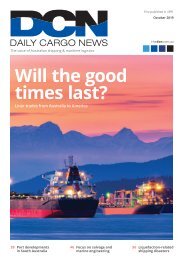DCN0718_Combined_150
Create successful ePaper yourself
Turn your PDF publications into a flip-book with our unique Google optimized e-Paper software.
LIFE IN THE SUPPLY CHAIN<br />
Logistics growth in Asia –<br />
the view from Singapore<br />
SCLAA national chairman Amanda O’Brien writes about China, conferences, trade,<br />
diversity and bringing about change in the logistics industry<br />
THE SCLAA CONTINUES TO GROW<br />
its presence in global markets.<br />
Attending as a guest of LogiSYM for<br />
one of Asia’s largest logistics and supply<br />
chain conferences in Singapore, it was<br />
evident supply chains face the greatest<br />
challenge in the next decade. Resilience,<br />
innovation and internal capabilities<br />
of organisations were highlighted<br />
as key themes to sustain long-term<br />
viability. The ability of companies to<br />
maintain speed and flexibility in a<br />
highly technological market is essential<br />
to sustaining robust supply chains.<br />
There are great benefits generated from<br />
increased supply-chain pipeline velocity,<br />
profitability and performance. The twoday<br />
conference was hosted at the NUSS<br />
Kent Ridge Guild House in Singapore<br />
and brought together 300-plus shippers,<br />
manufacturers, 3PLs, forwarders,<br />
logistics professionals, educators and<br />
technology providers from around<br />
Asia. This is the fourth time LogiSYM<br />
has hosted an event in Singapore in<br />
partnership with The Logistics and<br />
Supply Chain Management Society,<br />
which is Asia’s premier peer-to-peer<br />
members’ only logistics practitioners’<br />
association. The symposium aimed to<br />
bridge the gap between supply chain<br />
concepts and technology and real world<br />
implementation.<br />
COLLABORATION<br />
Can we really predict what requirements<br />
are needed in the supply chain areas<br />
over the next 40 years, or even the<br />
coming decade? Certainly not. In the<br />
new normal everything and anything is<br />
possible. We have come to expect natural<br />
disasters and the need to make faster<br />
decisions. We are already working in<br />
the midst of megatrends, globalisation,<br />
urbanisation, shifting economic powers<br />
and scarcity of natural resources, nextgeneration<br />
technologies and climate<br />
change. Efficient urban logistics is an<br />
increasing requirement, and distribution<br />
centres or hubs on city outskirts will<br />
be required to accommodate increasing<br />
population and demanding consumer<br />
driven online buying.<br />
CHINA’S PLAN<br />
At the conference the Belt and Road<br />
Initiative was articulately presented by<br />
Ton Van Den Bosch, energy terminals<br />
and infrastructure lawyer at Ince &<br />
Co LLP. Ton is the global head of Ince<br />
& Co’s ports, logistics and terminals<br />
practice and head of projects and energy<br />
in Asia. He has particular expertise in<br />
frontier and emerging markets in Africa<br />
and Asia. The Belt and Road Initiative<br />
is President Xi Jinping’s strategic vision<br />
to strengthen the long-term economic<br />
and social prosperity of participating<br />
countries and to enhance global trade<br />
and investment connectivity. To date,<br />
60 countries have shown interest. In<br />
2014 Xi Jinping, in his address to the<br />
Australian parliament, said China<br />
welcomed Australia’s participation in<br />
the “maritime Silk Road”. Australia<br />
and China have a strong relationship<br />
strengthened by the China-Australia<br />
Free Trade Agreement. China is one of<br />
our most important trading partners.<br />
BELT AND ROAD IN AUSTRALIA<br />
For Australia, the Belt and Road<br />
Initiative means expanding outbound<br />
and inbound trade and investment<br />
opportunities, and the Initiative is<br />
important to Australia’s infrastructure<br />
development. Trade between China and<br />
Australia was valued at $130bn in 2013<br />
(that is just under 24% of our total trade<br />
in goods and services, making China by<br />
far the most important single market for<br />
Australian exports). China is Australia’s<br />
largest trading partner for imports and<br />
exports. Australia is China’s sixth largest<br />
trading partner. Some 25% of Australian<br />
manufactured imports come from China<br />
Above: Amanda O’Brien, Supply Chain<br />
and Logistics Association of Australia<br />
national chairman<br />
and 13% of its exports are thermal coal<br />
to China. Ton stated that US$1.3 trillion<br />
globally had already been invested in the<br />
Belt and Road Initiative.<br />
BUILD BETTER BUSINESS<br />
Dr John Gattorna, a world expert and<br />
global supply chain thought leader and<br />
author, opened as keynote speaker at the<br />
global logistics conference in Singapore.<br />
He said growth through turbulence and<br />
volatility drives innovation. Looking<br />
outside of our businesses and seeing<br />
trends and different core relationships<br />
assists us to understand expectations of<br />
customers.<br />
He said most businesses manage<br />
vertically, but customers manage<br />
horizontally and changing the design<br />
of customers’ demands would enable<br />
organisations to sense key markets and<br />
internal capabilities to adapt.<br />
Agility to make fast decisions and<br />
changes in a volatile environment<br />
is key he said, giving the example of<br />
Zara, which has had 16 or 17 product<br />
changes in a year and maintain a<br />
Image supplied<br />
18<br />
First published in 1891<br />
July 2018<br />
thedcn.com.au

















